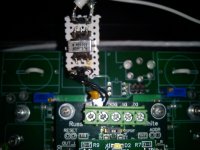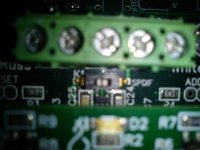Not quite. They define the absolute phase if used in their default value. But changing some of the dacs will result in undocumented behavior.
(edit) I read your description again. I think it sounds right.
(edit) I read your description again. I think it sounds right.
Last edited:
Glt,
I saw the last version of your code. I made the modifications to use it in dual mono, added the fumction to use selectmode with the remote and the master trim.
Question: what is the story about the de-emphasis? I don't remember TP, but it looks like you disable that. I don't knowuch on the matter, but from what I read on internet, shouln't it be emabled? It appears in two different register values.
Thanks,
Davide
I saw the last version of your code. I made the modifications to use it in dual mono, added the fumction to use selectmode with the remote and the master trim.
Question: what is the story about the de-emphasis? I don't remember TP, but it looks like you disable that. I don't knowuch on the matter, but from what I read on internet, shouln't it be emabled? It appears in two different register values.
Thanks,
Davide
The DACB phase registers are relative to the DAC phase of each DAC. They are not absolute.
De-emphasis on the ES9018 is handled automatically if the SPDIF decoder detects that the signal has emphasis. Very few CDs are encoded this way. We just leave this as default since it is only turned on by the DAC when it is needed. Which is truly rare. 🙂
De-emphasis on the ES9018 is handled automatically if the SPDIF decoder detects that the signal has emphasis. Very few CDs are encoded this way. We just leave this as default since it is only turned on by the DAC when it is needed. Which is truly rare. 🙂
Thanks Russ and Davide for sharing the info.
I don't think I would have figured it out through experimentation in a million years.
I might add that the remapping behavior also happens when you reduce the number of (digital parts) dacs due to increasing the quantizer bit size.
Experiment: Consider the even dacs. Use 8-bit quantizer (this turns off 2 or the 4 even dacs). If you flip the phase on all the even dacs, you get silence.
This may be a detail for BIII users in dual mono: Use 6-bit or 7-bit and no source remap (and all 4 dacs have the phase flipped) Switch to 8-bit or 9-bit and then you get silence...
Another observation: if DACXB is in relation to DACX, in what situation would you use DACXB in-phase with DACX?
I don't think I would have figured it out through experimentation in a million years.
I might add that the remapping behavior also happens when you reduce the number of (digital parts) dacs due to increasing the quantizer bit size.
Experiment: Consider the even dacs. Use 8-bit quantizer (this turns off 2 or the 4 even dacs). If you flip the phase on all the even dacs, you get silence.
This may be a detail for BIII users in dual mono: Use 6-bit or 7-bit and no source remap (and all 4 dacs have the phase flipped) Switch to 8-bit or 9-bit and then you get silence...
Another observation: if DACXB is in relation to DACX, in what situation would you use DACXB in-phase with DACX?
glt some of what you are seeing is because of the physical connections as much as the internal remapping. 🙂
You should get a B3 so you can play around in earnest. 🙂
You should get a B3 so you can play around in earnest. 🙂
glt some of what you are seeing is because of the physical connections as much as the internal remapping. 🙂
You should get a B3 so you can play around in earnest. 🙂
In due time, in due time 🙂
Right now is more fun dealing with the limitations of BII 🙂
Another observation: if DACXB is in relation to DACX, in what situation would you use DACXB in-phase with DACX?
Guess if you want to turn the chip on a SE output.
D.
I want to change my BII 80MHz clock for the new 100MHz clok to avoid drop-outs, it's easy to change? wich 100MHz clock will be plug & play, another Crystek? TP sells separately only the new clock for BII users?
You want the Crystek CCHD950-25-100, available from Mouser.
CCHD-950-25-100.000 Crystek Corporation Standard Clock Oscillators
We have them build by Crystek in batches but the quantities are aligned with the DACs we need to build, so we don't have extras floating around. When I prototype, I buy a few from Mouser.
As for ease of replacement, that really depends on the tools and skills available to you. I would typically use a hot-air rework station. Since it doesn't have pins, it's almost impossible to remove with an iron, unless you want to dissect the XO and systematically cut it up (destroy it).
CCHD-950-25-100.000 Crystek Corporation Standard Clock Oscillators
We have them build by Crystek in batches but the quantities are aligned with the DACs we need to build, so we don't have extras floating around. When I prototype, I buy a few from Mouser.
As for ease of replacement, that really depends on the tools and skills available to you. I would typically use a hot-air rework station. Since it doesn't have pins, it's almost impossible to remove with an iron, unless you want to dissect the XO and systematically cut it up (destroy it).
Guess if you want to turn the chip on a SE output.
D.
You are right. Datasheet says that feature is to allow all the DACs to be summed, for example to drive (directly in voltage mode) an amplifier...
I want to change my BII 80MHz clock for the new 100MHz clok to avoid drop-outs, it's easy to change? wich 100MHz clock will be plug & play, another Crystek? TP sells separately only the new clock for BII users?
I have outlined a non-destructive method here: BII 80MHz + 352.8KHz Audio + Silence = Noise H i F i D U I N O (have not done it myself but looks good on paper 🙂 )
You want the Crystek CCHD950-25-100, available from Mouser.
CCHD-950-25-100.000 Crystek Corporation Standard Clock Oscillators
We have them build by Crystek in batches but the quantities are aligned with the DACs we need to build, so we don't have extras floating around. When I prototype, I buy a few from Mouser.
As for ease of replacement, that really depends on the tools and skills available to you. I would typically use a hot-air rework station. Since it doesn't have pins, it's almost impossible to remove with an iron, unless you want to dissect the XO and systematically cut it up (destroy it).
Thanks, I have a hot-air station so I ordered the 100MHz clock to Mouser.
I have outlined a non-destructive method here: BII 80MHz + 352.8KHz Audio + Silence = Noise H i F i D U I N O (have not done it myself but looks good on paper 🙂 )
Thank you, very illustrative link with nice pics.
I am not an expert, but ...
From the datasheet, you can see that phase noise numbers are comparable to CCHD-950, BUT at 10MHz carrier which means that its much worse at 100MHz frequency. And then you compare the price, etc. I think you're better of with CCHD-950.
Regards, Kovax
Is there any difference between both sourcing of cristals?You want the Crystek CCHD950-25-100, available from Mouser.
CCHD-950-25-100.000 Crystek Corporation Standard Clock Oscillators
We have them build by Crystek in batches but the quantities are aligned with the DACs we need to build, so we don't have extras floating around. When I prototype, I buy a few from Mouser.
As for ease of replacement, that really depends on the tools and skills available to you. I would typically use a hot-air rework station. Since it doesn't have pins, it's almost impossible to remove with an iron, unless you want to dissect the XO and systematically cut it up (destroy it).
No they are the same, the only difference is in the frequency tolerance grade, and that is very small indeed. 🙂I would not hesitate to use the Mouser stock part.
BII glitches/dropouts
After adding a pulse tx with a 75R & a 0.01uF ceramic cap still I have glitches/dropouts each 6 or 7 songs, stops 2 or 3 seconds & starts again playing.
I'm using S/PDIF input with hiFace & with a CD transport, with both I have the same issue, I tried to use D1 input instead S/PDIF changing the switch S/PDIF to off but no sound, the problem is with all formats 16bits/44kHz (CD transport) or hirez files with hiFace usb-s/pdif 24bits/192kHz or 24bits/352.8kHz (hiFace usb-s/pdif)
I left the DAC powered 30 minutes or more before playing music.
I heard changing the clock solves the problem for hirez files but my problem is with all formats, any idea to fix the issue?
AVCC module LED D2 don't lit
Attached pics pulse tx & S/PDIF switch in ON position.
After adding a pulse tx with a 75R & a 0.01uF ceramic cap still I have glitches/dropouts each 6 or 7 songs, stops 2 or 3 seconds & starts again playing.
I'm using S/PDIF input with hiFace & with a CD transport, with both I have the same issue, I tried to use D1 input instead S/PDIF changing the switch S/PDIF to off but no sound, the problem is with all formats 16bits/44kHz (CD transport) or hirez files with hiFace usb-s/pdif 24bits/192kHz or 24bits/352.8kHz (hiFace usb-s/pdif)
I left the DAC powered 30 minutes or more before playing music.
I heard changing the clock solves the problem for hirez files but my problem is with all formats, any idea to fix the issue?
AVCC module LED D2 don't lit
Attached pics pulse tx & S/PDIF switch in ON position.
Attachments
If the AVCC LED is not lighting this leads me to ask:
What is the supply voltage while it is not lit?
What is the supply voltage while it is not lit?
AVCC module LED D2 don't lit
It sounds like you don't have enough current...
- Status
- Not open for further replies.
- Home
- More Vendors...
- Twisted Pear
- Buffalo II

